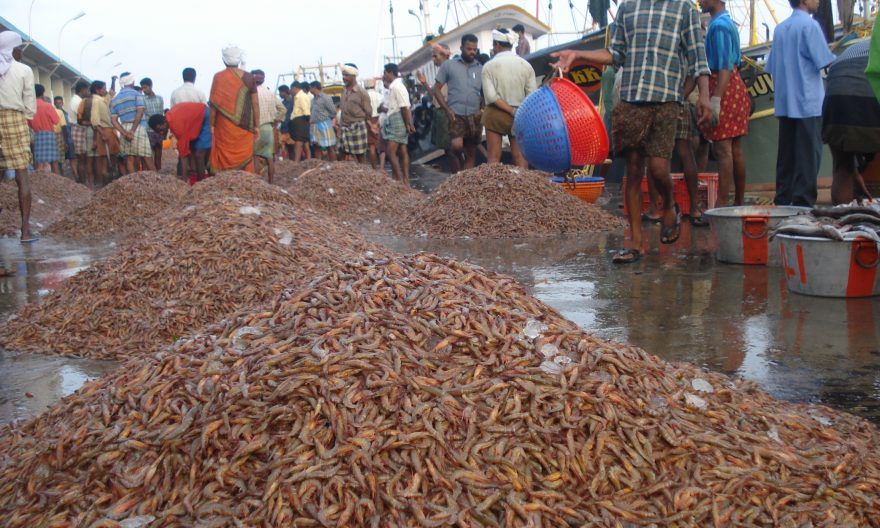
konnivartha.com: മൺസൂൺ കാലത്തെ ട്രോളിംഗ് നിരോധനം കൊണ്ട് പൊതുവെ കരുതിയിരുന്നത് പോലെ കരിക്കാടി ചെമ്മീൻ സമ്പത്തിന് നഷ്ടമൊന്നും സംഭവിക്കുന്നില്ലെന്ന് പഠനം. മറിച്ച്, കടലിൽ കരിക്കാടി ചെമ്മീൻ സമ്പത്തിന്റെ സുസ്ഥിരവളർച്ചയക്ക് നിരോധനം ഗുണകരമാണെന്ന് കേന്ദ്ര സമുദ്രമത്സ്യ ഗവേഷണ സ്ഥാപനത്തിന്റെ (സിഎംഎഫ്ആർഐ) പഠനം വെളിപ്പെടുത്തുന്നു.
ട്രോളിംഗ് നിരോധനം കാരണം പിടിച്ചെടുക്കാൻ കഴിയാതെ പോകുന്ന കരിക്കാടി ചെമ്മീൻ സമ്പത്ത്, തീരക്കടലുകളിൽ നിന്ന് ഇവ പിന്നീട് ആഴക്കടലുകളിലേക്ക് നീങ്ങുന്നതിനാൽ എന്നെന്നേക്കുമായി നഷ്ടപ്പെടുമെന്ന് മത്സ്യത്തൊഴിലാളികൾ ഭയന്നിരുന്നു. നിരോധനം നടപ്പിലാക്കിയതിനെ തുടർന്നുണ്ടായ ലഭ്യതയിലെ ഏറ്റക്കുറച്ചിലുകളാണ് ഈ ധാരണക്ക് വഴിയൊരുക്കിയത്. എന്നാൽ, ഉപ്പിന്റെ അളവ് കൂടുതലുള്ള ആഴക്കടലുകളിലേക്ക് ഇവ നീങ്ങുന്നുണ്ടെന്ന് കണ്ടെത്തിയെങ്കിലും ട്രോളിംഗ് നിരോധനം കഴിഞ്ഞയുടൻ 50 മുതൽ 100 മീറ്റർ വരെ ആഴങ്ങളിൽ നിന്ന് ഈ ചെമ്മീൻ പിടിക്കാൻ സാധിക്കുമെന്ന് സിഎംഎഫ്ആര്ഐ പഠനം പറയുന്നു.
മാത്രമല്ല, മൺസൂൺകാലങ്ങളിൽ തീരക്കടലുകളിൽ വളരെ ചെറിയ ഇനം ചെമ്മീനുകളാണ് കാണപ്പെടുന്നത്. ഇക്കാലയളവിൽ മത്സ്യബന്ധനം നിയന്ത്രിക്കുന്നതിലൂടെ അവയുടെ പ്രജനനം തുടരാനും കൂടുതൽ അളവിലും വലിപ്പത്തിലും വളർച്ച കൈവരിക്കാനുമാകുന്നു. ഇക്കാരണത്താൽ, മൺസൂൺകാല ട്രോളിംഗ് നിരോധനം കരിക്കാടി ചെമ്മീൻ സമ്പത്തിന് ഏറെ ഗുണകരമാണെന്ന് പഠനം ചൂണ്ടിക്കാട്ടുന്നു.
ട്രോളിംഗ് നിരോധന ശേഷമുള്ള ആഗസ്ത്-സെപ്തംബർ മാസങ്ങളിൽ 50 മുതൽ 100 മീറ്റർ വരെ ആഴങ്ങളിൽ നിന്ന് മികച്ച വളർച്ച നേടിയ കരിക്കാടി ചെമ്മീൻ പിടിക്കാവുന്നതാണ്. മഴക്കാലത്ത് തീരക്കടലുകളിൽ ഉപ്പിന്റെ അംശം കുറയുന്നത് കാരണമാണ് ഇവ ആഴക്കടലുകളിലേക്ക് മാറുന്നത്. പിന്നീട് തീരക്കടലുകളിൽ ഉപ്പിന്റെ അളവ് അനുകൂലമാകുന്നതോടെ പിടിച്ചെടുക്കാതെ പോകുന്ന വലിയൊരു വിഭാഗം കരിക്കാടി ചെമ്മീൻ സമ്പത്ത് തീരക്കടലുകളിലേക്ക് തിരിച്ചെത്തുന്നതായും പഠനത്തിൽ കണ്ടെത്തി. റീജ്യണൽ സ്റ്റഡീസ് ഇൻ മറൈൻ സയൻസ് എന്ന ജേണലിൽ ഈ പഠനം പ്രസിദ്ധീകരിച്ചിട്ടുണ്ട്.
ട്രോൾ മത്സ്യത്തൊഴിലാളികൾ പ്രകടിപ്പിച്ച ആശങ്കയുടെ അടിസ്ഥാനത്തിലാണ് ഈ പഠനം നടത്തിയതെന്ന് സിഎംഎഫ്ആർഐ ഷെൽഫിഷ് ഫിഷറീസ് ഡിവിഷൻ മേധാവി ഡോ എ പി ദിനേശ്ബാബു പറഞ്ഞു. കരിക്കാടി ചെമ്മീനിന്റെ കടലിലെ സഞ്ചാരവും ഏതൊക്കെ പാരിസ്ഥിതിക ഘടകങ്ങളാണ് അവയെ സ്വാധീനിക്കുന്നതെന്നും മാപ്പിംഗിലൂടെ ശാസ്ത്രീയമായി കണ്ടെത്താൻ പഠനം സഹായിച്ചെന്നും അദ്ദേഹം പറഞ്ഞു.
Monsoon trawl ban not detrimental to Karikadi prawn resources, reveals CMFRI study
A new study by the ICAR-Central Marine Fisheries Research Institute (CMFRI) has found that the monsoon trawl ban is not detrimental to kiddi (karikadi) prawn resources. The study, instead, has reaffirmed the efficacy of trawl ban by demonstrating its role in ensuring the long-term viability of the karikadi fishery along the Kerala coast particularly by fostering species recruitment during the monsoon season.
Kiddi prawn (Parapenaeopsis stylifera) is a substantial fishery along India’s southwest coast due to its high demand in domestic and international markets. Fluctuations in the karikadi catch following the implementation of mechanised fishing ban during the monsoon season had led fishermen to believe that unharvested prawns would be lost forever as these resources moved away from the nearshore to deeper waters.
However, CMFRI’s study found that even as these species do migrate to deeper areas, they remain accessible to current fishing methods from areas at a depth of 50 to 100 meter immediately after the trawl ban period. “Monsoon rainfall drives karikadi prawns to deeper waters due to their preference for high salinity and low temperatures”, the study said.
Moreover, the karikadi population in near-shore waters during the monsoon season is exclusively made up of juveniles, according to this study. Restricting fishing during this period facilitates continued recruitment of prawns, enabling the resources to grow in size and numbers. As a result, the southwest monsoon trawl ban is advantageous to this species, the study observed.
“Trawling activity can be focused towards 50 – 100 m depth between August – September (immediately following the ban period) to collect the resource that migrates to deeper waters during the monsoon”, the study suggested.
Further, it also found that one part of unharvested large-sized karikadi prawns are getting resettled along the Indian coast, once the salinity is at their preferable range in the coastal waters. The study was published in the latest issue of Regional Studies in Marine Science. “This study was carried out to address the socio economic issues raised by the trawl fishermen of Kerala during a stakeholder meeting held at CMFRI”, said Dr A P Dineshbabu, Head of the Shellfish Fisheries Division of CMFRI and the lead author of the study.
The study provided scientific evidence for how this species is distributed uniquely, using GIS-based spatial distribution tracking to explore how the movement and maturity of kiddi prawns correlate with environmental factors, he added.
